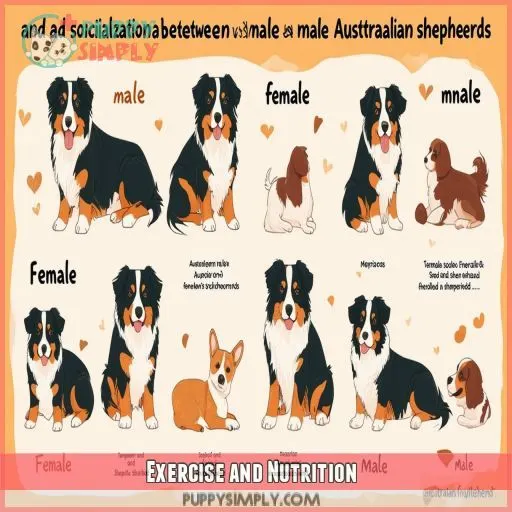This site is supported by our readers. We may earn a commission, at no cost to you, if you purchase through links.

Both have character traits related to energy levels and training needs. From that understanding, you will then be able to learn about their temperaments and behavioral shifts, deciding ultimately which may work best for your lifestyle or personal training ability.
Ready to find out more? Read on to find out which Aussie is best for you
Table Of Contents
- Key Takeaways
- Are Male or Female Australian Shepherds Easier to Train?
- Choosing the Right Australian Shepherd
- Male Australian Shepherds
- Female Australian Shepherds
- Training Differences
- Territorial Behavior
- Health and Care
- Exercise and Nutrition
- Temperament and Socialization
- Coat and Grooming
- Breed Popularity and Insurance
- Frequently Asked Questions (FAQs)
- Should I get a male or female Australian Shepherd?
- Which gender dog is easier to train?
- Are Australian Shepherd dogs hard to train?
- Is it easier to potty train a boy or girl dog?
- Is a female Australian Shepherd hard to train?
- Are female Australian Shepherds better than boys?
- Do male Australian Shepherds fight over territory?
- Can a male Australian Shepherd mate?
- How do hormones affect training in intact Australian Shepherds?
- Are there age-specific training challenges for each gender?
- Do male and female Aussies respond differently to rewards?
- How does pack hierarchy influence training mixed-gender groups?
- Are there gender differences in herding instinct trainability?
- Conclusion
Key Takeaways
- Both male and female Aussies have their own quirks, but it’s the dog’s personality that truly takes the cake when it comes to trainability. Don’t judge a book by its cover – or in this case, a shepherd by its gender!
- Consistency is king (or queen) in training these clever canines. Whether you’ve got a boy or girl Aussie, stick to your guns with positive reinforcement and you’ll have a well-behaved pup faster than you can say "fetch!"
- Spaying or neutering can be a game-changer for both genders. It’s like hitting the ‘chill pill’ button on some of those pesky hormonal behaviors that might throw a wrench in your training plans.
- At the end of the day, your bond with your furry friend trumps all. Put in the time, shower them with love (and treats), and you’ll have a loyal companion who’s eager to please – whether they’re sporting a pink or blue collar
Are Male or Female Australian Shepherds Easier to Train?
In the case of an Australian Shepherd, gender does not make that much difference. Both males and females of the Aussies can be about equally easy to train, having more to do with temperament than which sex is involved.
You would find that males are often rowdy and loving, while females might be more independent to a great extent. But both respond well to positive reinforcement and firm training. It simply means focusing on your pup’s character and energy level rather than gender.
Of course, if you’re interested in the differences between male and female Aussies, it’s not all about trainability
Choosing the Right Australian Shepherd
When choosing the right Australian Shepherd, consider both male and female options, as each has unique traits. Pay attention to their energy levels and training needs to find a dog that fits your lifestyle
Male Vs Female
Choosing between a male or female Australian Shepherd depends on size differences, breed stereotypes, and behavioral variability. Male Aussie owners often find them cuddly and social, while female owners appreciate their independence. Focus on personality over gender when selecting from a litter, as each dog’s unique traits influence training ease. Both males and females can be easy to train
Energy Levels
Where energy level is concerned, the male Australian Shepherds seem to have more power compared to their female counterparts. Described more often as exuberant and playful, they need lots of exercise and mental stimulation, just like the females, to stay out of trouble and maintain good behavior. Here are four tips for managing an Aussie’s energy:
- Give them some type of daily exercise, for example, hiking, swimming, agility training, among others.
- Engage them with puzzle toys, training sessions, and nose work so that they get a mental challenge.
- Active lifestyle—consider one that will match the energy needs of your Aussie.
- Socialize early and often to channel their enthusiasm in positive ways
Training Needs
Training Australian Shepherds involves using reward-based techniques like crate and leash training to enhance behavior and housebreaking skills. Both genders respond well to socialization training, adapting to different settings and personalities. Regular grooming keeps them healthy, and consistent housebreaking helps establish routines. Focus on positive reinforcement to maintain their engaging, energetic nature
Male Australian Shepherds
Male Australian Shepherds are often more affectionate and exuberant, which can make training sessions lively but also challenging if they’re too energetic. Their larger size and higher energy levels require consistent training and exercise to keep them focused and obedient
Temperament
The male Australian Shepherd is of an affectionate and loyal character. Often, it will create a strong bond with its family and develop a playful and protective personality.
While they’re considerably territorial from their herding instincts, they generally have a sociable character and are keen to please.
These dogs live approximately 12-15 years; therefore, they’ve many years left to spend with their family
Training
Training male Australian Shepherds can be very rewarding due to their true motivation and energy, which makes them interested in learning. Here are some tips to help you succeed with this herding breed.
- Positive Reinforcement: Praise and treats are the way to go.
Involve obedience school: It builds skills and socialization.
- Try clicker training: It improves focus.
- Stay patient: Consistency and kindness matter
Size Differences
Male Australian Shepherds are larger, and there’s a noticeable size difference between them and their female counterparts. Height can differ by 1-2 inches taller. Their weight varies by up to 5-15 pounds more. This makes males physically more powerful, thus exerting their presence and strength. Physical differences need to be considered in cases of handling or requirements regarding space.
Female Australian Shepherds
Now that we’ve considered the male Australian Shepherds, let’s look into the females. Like their male counterparts, females have a few of their tendencies.
Generally, spayed females are much less likely to have territorial behavior and marking issues than intact females. Another advantage to spaying is that it reduces the potential risk for reproductive cancers and heat cycles. They may also be more independent and introverted hence they may like to be in charge sometimes. That doesn’t mean they can’t develop a deep attachment with their owners.
Appreciation for health differences is also necessary—for instance, urinary infections are much more common in females. With the right approach, female Aussies can make excellent companions
Training Differences
In training the Australian Shepherds, one finds that males and females have different habits and temperaments. Using tips that work for you, coupled with determination, you’ll find it relatively easy to train either gender and make them well-behaved and well-controlled.
Breed Habits
Australian Shepherds are a breed with typical tendencies that make a difference in training. Depending on the personality, some males may tend to be more rambunctious, while females lean toward being focused; however, litter selection can play an important role.
Watching for these traits and using the Volhard aptitude test will give you a good guide. There are explicit behaviors with male vs. female puppies best suited for specific roles, but health concerns can also impact their trainability
Training Tips
First, think about constant training methods that go hand in hand with the personality traits of your Australian Shepherd. Males have high energy and, therefore tend to react very well to energetic, engaging sessions. If you own a female, then she’s focused, so she works well under structured routines. Remember:
- Socialize early to prevent territorial behaviors.
- Positive reinforcement in both genders.
- Address health issues promptly to ensure consistent training progress
Territorial Behavior
Territorial behavior can be managed effectively in both male and female Australian Shepherds, particularly through neutering or spaying. Neutering or spaying reduces tendencies like marking territory and can make training easier
Marking Territory
Marking territories is a widespread behavior in Australian Shepherds, regardless of their gender. Typical reasons behind marking territories include dominance and communication with other dogs.
Keeping your dog away from doing this at home is necessary if you’re house-training him. Neutering and spaying will reduce the act of marking.
Keeping up with routine, taking sufficient breaks to go outside, and positive reinforcement will keep this instinct under control
Neutering/Spaying
Neutering or spaying your Australian Shepherd offers numerous benefits. Neutering males prevents marking and reduces aggression, making them easier to train. Spaying females curbs territorial behavior and eliminates heat cycles. Both procedures contribute to behavior modification, leading to a calmer, more obedient dog. These interventions ultimately enhance your pet’s wellbeing and household harmony
Health and Care
Australian Shepherds typically live between 12-15 years and can face health conditions like cancer or reproductive issues, depending on gender. Regular vet check-ups, a balanced diet, and proper exercise are essential to keep your dog healthy and happy
Life Expectancy
When considering life expectancy for both male and female Australian Shepherds, you can expect them to live between 12-15 years. Key factors influencing their longevity include:
- Breed Size: Larger dogs generally face more health issues.
- Health Conditions: Monitor for breed-specific ailments.
- Litter Selection: Choose healthy puppies.
- Volhard Aptitude Test: Helps select well-adjusted pups
Common Health Problems
In consideration of common health problems in the Australian Shepherds, there are sex-specific issues. Males are predisposed to prostatic hyperplasia or testicular cancer, while females have mammary cancer and other issues with the reproductive organs.
Therefore, spaying and neutering are essential and often reduce these risks. Regular visits to the vet, along with preventative care, will keep your Aussie healthy and happy
Vet Tips
Take good care of your Australian Shepherd—here are some vet tips:
- Spaying or Neutering: Reduces health concerns related to hormones.
- Regular Check-ups: To provide for early identification of problems such as hip dysplasia and eye disorders.
- Balanced Diet and Exercise: Maintain an ideal weight to eliminate joint complications.
These practices support overall health and positively impact temperament and training ease.
Exercise and Nutrition
Both male and female Australian Shepherds require lots of exercise to be showered with health and happiness. You’ll also need to include a good, well-balanced meal, with the proper intake corresponding to his activity level and life stage, to maintain the dog’s overall health.
Exercise Needs
Your Australian Shepherd needs ample exercise to thrive. Aim for at least an hour of active play daily.
| Indoor Exercise Options | Description |
|---|---|
| Tug-of-War | Engages muscles and mind |
| Hide and Seek | Stimulates mental agility |
| Obedience Training | Sharpens commands and focus |
| Treadmill Workouts | Keeps up daily activity levels |
Incorporate agility training for well-rounded fitness
Dietary Requirements
This will ensure that the diet and nutritional needs and any dietary restrictions are considered in feeding your Australian Shepherd. He needs a balanced diet for his energetic lifestyle. Be concerned about food allergies and set up a feeding schedule with a constant number of mealtimes for each day.
- Balanced diet: Ensure consuming a mix of proteins, fats, and carbohydrates.
- Check for allergy: Be aware of reactions against foods.
- Regular feeding schedule: Stick to regular meal times
Healthcare Tips
Keep your Australian Shepherd in tip-top shape by ensuring regular exercise and a balanced diet. Neutering or spaying helps prevent certain health conditions. Schedule vet check-ups to catch potential issues early. Tailor exercise needs to their energy level—daily walks and playtime are essential. Follow these healthcare tips for a happy, healthy, and active dog
Temperament and Socialization
While males might be a little more rowdy, both the male and female Australian Shepherd can be good with children. It’s also known that females show more territorial behaviors in general, while males are usually more demonstrative and eager to establish strong bonds.
How Good With Kids
Australian Shepherds, both male and female, are generally great with kids. Their friendly temperament and socialization skills make them excellent family pets. They’re playful, protective, and affectionate, making them a hit with children.
- Patience with kids
- Playfulness
- Protective nature
- Adaptability to family routines
- Low aggression potential
These traits highlight their compatibility with young families
Affection Levels
Male and female Australian Shepherds offer varying affection levels. Males, generally more affectionate, often seek companionship and physical closeness. Females can be affectionate but might prioritize independence. This difference impacts bonding and training approaches. Here’s a quick comparison:
| Affection Trait | Male | Female |
|---|---|---|
| Physical Closeness | High | Moderate |
| Bonding Levels | Strong | Variable |
| Clinginess | Higher | Lower |
| Independence | Less | More |
Territoriality
Both males and females of the breed of dog can display territorial behavior. Males appear to mark the most, but due to territoriality, neutering significantly decreases this trait.
Females also don’t mark as much if they’re spayed. This characteristic is definitely due to hormonal influence, and therefore, spaying or neutering is highly recommended.
Territorial actions can be limited in both sexes with constant guidance and training
Coat and Grooming
Australian Shepherds have a dense double coat that requires regular grooming to manage shedding and maintain health. Typically, males may have thicker coats than females, so grooming frequency might be higher for male dogs
Coat Type
Australian Shepherds have a double coat, with regular care needed for this breed.
The coat length varies, but you’ll reasonably naturally expect a medium to long outer jacket accompanied by a thick undercoat.
Coat colors and patterns vary: Merle, black, red, tri-colored.
Keeping the coat cared for in thickness or thinness will ensure your Aussie is looking sharp and comfortable year-round
Shedding Levels
Australian Shepherds have a double coat, which leads to significant seasonal shedding. Males generally have thicker coats than females, so their shedding frequency might be higher. Both genders require frequent grooming to manage loose hair and maintain coat health. Regular brushing helps control shedding and reduces the risk of mats, keeping your Aussie looking sharp and comfortable
Grooming Frequency
You will have to groom your Australian Shepherd once a week due to their medium shedding.
Brushing their fur regularly using the appropriate brushes will help you keep it healthy and prevent tangling.
It would be best to bathe them every 6-8 weeks or whenever events call for it.
This grooming frequency ensures that the double coat is kept clean and manageable and reduces shedding and matting
Breed Popularity and Insurance
Australian Shepherds are popular dogs known for their intelligence and adaptability, making them a favorite among active families. When considering insurance, both male and female Australian Shepherds can incur similar costs, though individual health conditions may influence premiums
Popularity
Australian Shepherds have surged in popularity due to their intelligence and versatility. Pop culture, like movies and dog shows, often highlights their agility and trainability, boosting their reputation. This breed is especially favored in rural areas for herding, but urban dog lovers appreciate their adaptability. Despite health considerations, their friendly temperament keeps them in high demand across regions
Insurance Costs
Given that it’s a popular breed, you’ll find the insurance premiums for an Australian Shepherd can swing wildly. Usually, insurance companies look at prevalent breeds—like Aussies—to be bred for insurance. The price might be more significant because of this.
However, most of the insurance plans provide better discounts for breed-specific considerations. It’s always a good idea to compare the different plans and ensure you get the best coverage for your bundle of energy
Frequently Asked Questions (FAQs)
Should I get a male or female Australian Shepherd?
Your choice depends on your lifestyle and preferences. Males are often more playful and affectionate, while females can be more independent. Consider energy levels, size differences, and individual personalities. Ultimately, both genders make great companions with proper training and care
Which gender dog is easier to train?
Training ease depends more on individual temperament than gender. You’ll find both male and female Australian Shepherds quick learners. Focus on consistent training methods, positive reinforcement, and early socialization to shape your pup into a well-behaved companion
Are Australian Shepherd dogs hard to train?
While not hard to train, Australian Shepherds can be too keen to learn. You’ll find them very intelligent and responsive to any consistent training method. Be patient with them, and apply positive reinforcement strategies consistently to shape their behavior well enough to be an excellent companion or work dog.
Is it easier to potty train a boy or girl dog?
As far as potty training is concerned, you’re barking up the wrong tree if you think gender matters much. Both boys and girls can learn fast enough. That’s all about insistence, patience, and positive reinforcement—nothing to do with their sex.
Is a female Australian Shepherd hard to train?
Female Australian Shepherds aren’t inherently difficult to train. They’re both intelligent and please-hungry dogs, so they do have the potential to pick up quickly. With consistent positive reinforcement, you’ll find your Aussie girl very responsive and capable. Be patient and devoted, and the results will be excellent.
Are female Australian Shepherds better than boys?
Imagine Sarah’s spirited female Aussie, Bella, effortlessly herding sheep. You’ll find both genders have unique strengths. Females often excel in focus and attentiveness, while males can be more independent. It’s the individual dog’s personality that truly matters
Do male Australian Shepherds fight over territory?
Male Australian Shepherds can exhibit territorial behavior, especially if unneutered. However, proper training and socialization can minimize this issue. You’ll find that neutering your pup and establishing clear boundaries will help prevent territorial disputes between males
Can a male Australian Shepherd mate?
A male Australian Shepherd will mate like a well-oiled machine. You’ll want to consider his age, health, and temperament. Physically speaking, if he’s intact, he can breed. It’s vital to breed him responsibly with proper guidance.
How do hormones affect training in intact Australian Shepherds?
Hormones can make training intact Australian Shepherds challenging. You’ll notice increased distractibility and stubbornness in both sexes. Males may exhibit marking behaviors, while females experience mood changes during heat cycles. Consistent training and patience are key to overcoming these hurdles
Are there age-specific training challenges for each gender?
You’ll face different challenges at various ages for both genders. Puppies are generally easier to train, but males may be more distractible during adolescence. Females might experience mood swings during heat cycles if not spayed
Do male and female Aussies respond differently to rewards?
Males: food-driven, praise-responsive. Females: toy-motivated, affection-seeking.
You’ll find both genders respond well to positive reinforcement. Tailor rewards to your Aussie’s preferences, whether it’s treats, playtime, or cuddles, for effective training results
How does pack hierarchy influence training mixed-gender groups?
Pack hierarchy can impact training mixed-gender groups. You’ll need to establish yourself as the leader, regardless of dog genders. Consistent rules and fair treatment help maintain order and prevent dominance issues during training sessions
Are there gender differences in herding instinct trainability?
Like the shepherd’s whistle, guiding the flock is an inborn herding instinct in both sexes; individual differences have more bearing than sex. Knowing each dog’s character and what makes them tick will make all the difference in bringing forth that inner herder during their training.
Conclusion
Meet Sarah, who struggled to choose between male and female Australian Shepherds for training. After researching, she found that both sexes can be equally trainable with the right approach.
Whether you opt for a male or female Australian Shepherd, success depends on consistent training, early socialization, and understanding your dog’s unique personality. Remember, each Aussie is an individual.
Focus on building a strong bond, using positive reinforcement, and tailoring your methods to your dog’s needs. You’ll find that with patience and dedication, both male and female Aussies can become well-trained companions















